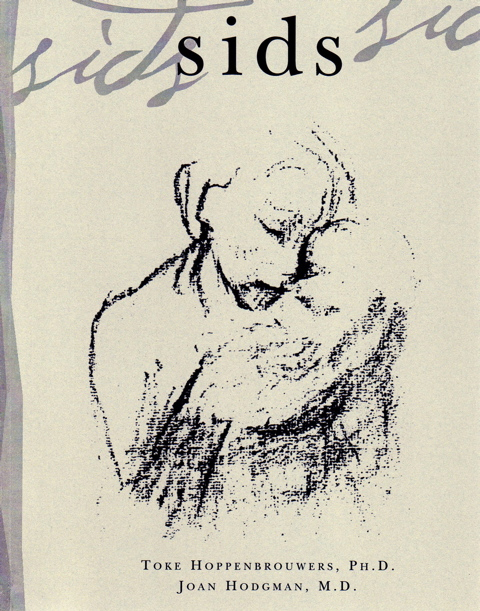Clinical Professor of Pediatrics, University of Southern California (USC), Keck School of Medicine, Los Angeles
|
S I D S By Toke Hoppenbrouwers, Ph.D. and Joan Hodgman, M.D. Please click here to download "SIDS" in PDF-format (2,1 Mb). Table of Contents Acknowledgments |
|
Part One Pr a c t i c a l I n f o r m a t i o n
- What is SIDS?
- The cause of SIDS is unknown
- What events will happen right after a baby dies of SIDS?
- How is the diagnosis of SIDS made?
1. death scene investigation
2. autopsy or postmortem examination
3. infanticide - Information about funerals
- Health Department Visiting Program
- Where can I get more information and help?
Part Two S I D S a n d G r i e f
- Introduction
1. why did my baby die?
2. grieving
3. mourning rituals
4. family support
5. funerals - What feelings are normal?
1. panic
2. disbelief
3. shock
4. guilt
5. sadness
6. anger
7. physical reactions - Do fathers react in their own way?
- Does SIDS have an impact on the relationship between mothers and fathers?
- When parents are teenagers
- How are siblings affected?
1. preschoolers
2. grade school children
a. participation in funerals
b. responses to loosing a sibling
c. physical changes
d. peer adjustment
3. teenagers
a. dealing with emotions
b. awareness of overprotection
c. peer adjustment - Grandparents
- How does SIDS affect caregivers other than parents?
- What are the expected long-term emotions?
- Thinking about a new baby
- Helpful suggestions from others who lost a child
1. writing about your child
2. ritual or memorial
3. help with the holidays - What others should not do
1. showing ignorance
2. avoiding
3. gossiping
4. thoughtless advice
5. belittling the loss - Where can I find counseling and practical help?
Part Three Me d i c a l I n f o r m a t i o n
- History of SIDS
- Evaluation of media announcements about SIDS
- Thinking about causes
1. single cause
2. multiple causes for SIDS
3. single cause with predisposing conditions
4. association does not mean cause
5. distinguishing between mechanism of death and cause of death - Potential mechanisms of death
1. abnormal or prolonged apnea
2. airway obstruction
3. heart failure - Time factors known to be associated with SIDS
1. age
2. sleep/time of night
3. season/temperature - Infant risk factors
1. premature babies
2. one of twins
3. subsequent siblings of SIDS
4. babies with an Apparent Life Threatening Event (ALTE)
a. ruling out known causes
b. Münchausen by proxy
5. colds - Other risk factors
1. smoking
2. air pollution
3. maternal drugs - Diagnosis and treatment of the infant at risk for SIDS
1. are there diagnostic tools to identify an infant at risk?
2. home monitoring as treatment
a. reasons not to monitor
b. reasons to monitor
3. treatment with drugs - Minimizing the risk for SIDS
1. what you can do before the baby comes
a. family planning
b. health education
c. diet and drugs
d. prenatal care
2. after the baby has arrived
a. sleeping position: “Back to Sleep”
b. bedding
c. temperature
d. breast feeding
e. pacifiers
f. well baby care
g. recognizing when your baby is sick
h. medicines
i. sleeping with the baby
Part Four T h e o r i e s a b o u t S I D S
- Discarded Theories
1. sleep apnea theory
2. allergies
3. thyroid hormone
4. vitamin deficiencies
5. immunizations
6. overwhelming viral infection - Controversial theories
1. sleeping environment
a. co-sleeping/suffocation from overlying
b. suffocation from bedding
2. heart problems such as a prolonged QT interval
3. lack of lung surfactant - Current theories
1. respiratory failure
2. heart failure
3. theoretical causes for respiratory and heart failure
a. the potential contribution of mild chronic hypoxia
b. failure to awaken from sleep or arousal failure/neurotransmitters
c. overwhelming response to infection - New directions/ research tools
1. molecular biology
2. brain scans - Conclusions: The future of the SIDS puzzle
- How you can help with SIDS research?
Gl o s s a r y
Appendix 1. Burial information
Appendix 2. Public Health Programs
Appendix 3. Addresses and websites
Appendix 4. Do’s and Dont’s when talking to parents who lost a baby to SIDS
Appendix 5. How to recognize whether your baby is ill
Appendix 6. Recommended reading
About the Authors
